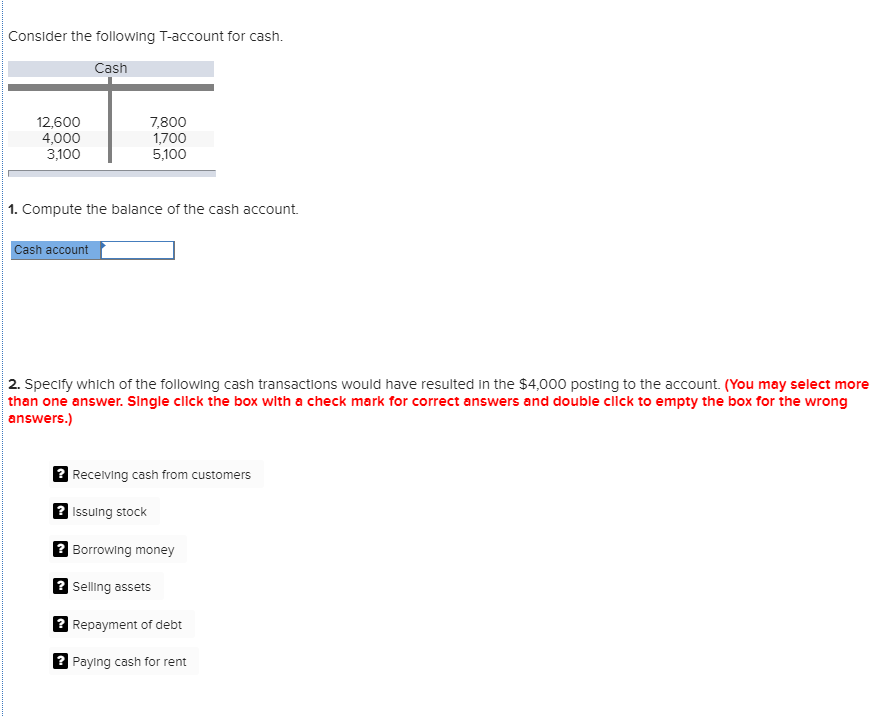

We now return to our company example of Printing Plus, Lynn Sanders’ printing service company. We will analyze and record each of the transactions for her business and discuss how this impacts the financial statements. Some of the listed transactions have been ones we have seen throughout this chapter. More detail for each of these transactions is provided, along with a few new transactions.
- In the journal entry, Accounts Receivable has a debit of $5,500.
- Accounts Receivable has a credit of $5,500 (from the Jan. 10 transaction).
- This similarity extends to other retailers, from clothing stores to sporting goods to hardware.
- On January 12, there was a credit of $300 included in the Cash ledger account.
- You will notice that the transactions from January 3, January 9, January 12, and January 14 are listed already in this T-account.
- Bookkeeping is the process of recording the financial transactions of a company on a regular basis.
Compute the balance of the cash account.
LO 3.5Indicate whether each of the following accounts has a normal debit or credit balance. LO 3.2LO 3.4West End Inc., an auto mechanic shop, has the following account balances, given in no certain order, for the quarter ended March 31, 2019. Based on the information provided, prepare West End’s annual financial statements (omit the Statement of Cash Flows). On this transaction, Supplies has a debit of $500. This will go on the debit side of the Supplies T-account. You notice there are already figures in Accounts Payable, and the new record is placed directly underneath the January 5 record.
Payment of dividends
LO 3.2Cromwell Corporation has the following trial balance account balances, given in no certain order, as of December 31, 2018. Retained Earnings at January 1, 2018, was $3,600. Using the information provided, prepare Cromwell’s annual financial statements (omit the Statement of Cash Flows). On this transaction, Cash has a credit of $3,500. This is posted to the Cash T-account on the credit side beneath the January 14 transaction.
Formatting When Recording Journal Entries
LO 3.5State whether the balance in each of the following accounts increases with a debit or a credit. LO 3.4Identify whether each of the following transactions would be recorded with a debit (Dr) or credit (Cr) entry. Let’s look at the journal entries for Printing Plus and post each of those entries quantity in math definition uses and examples video and lesson transcript to their respective T-accounts. Another key element to understanding the general ledger, and the third step in the accounting cycle, is how to calculate balances in ledger accounts. LO 3.2Consider the following accounts and determine if the account is an asset (A), a liability (L), or equity (E).
Compute the balance of the cash account:
Since this figure is on the credit side, this $300 is subtracted from the previous balance of $24,000 to get a new balance of $23,700. The same process occurs for the rest of the entries in the ledger and their balances. We know from the accounting equation that assets increase on the debit side and decrease on the credit side. If there was a debit of $5,000 and a credit of $3,000 in the Cash account, we would find the difference between the two, which is $2,000 (5,000 – 3,000).
Normal Account Balances
Accounts Payable has a debit of $3,500 (payment in full for the Jan. 5 purchase). You notice there is already a credit in Accounts Payable, and the new record is placed directly across from the January 5 record. Another example is a liability account, such as Accounts Payable, which increases on the credit side and decreases on the debit side. If there were a $4,000 credit and a $2,500 debit, the difference between the two is $1,500. Common Stock had a credit of $20,000 in the journal entry, and that information is transferred to the general ledger account in the credit column.


As a smaller grocery store, Colfax does not offer the variety of products found in a larger supermarket or chain. However, it records journal entries in a similar way. LO 3.5Journalize each of the following transactions or state no entry required and explain why. LO 3.4Identify the normal balance for each of the following accounts. LO 3.5Journalize for Harper and Co. each of the following transactions or state no entry required and explain why.
LO 3.5Prepare journal entries to record the following transactions. LO 3.5Determine whether the balance in each of the following accounts increases with a debit or a credit. On this transaction, Accounts Receivable has a debit of $1,200. The record is placed on the debit side of the Accounts Receivable T-account underneath the January 10 record. The record is placed on the credit side of the Service Revenue T-account underneath the January 17 record.
This is posted to the Unearned Revenue T-account on the credit side. Analyze the following transactions using the T account approach. Place the dollar amount on the debit and credit sides.
